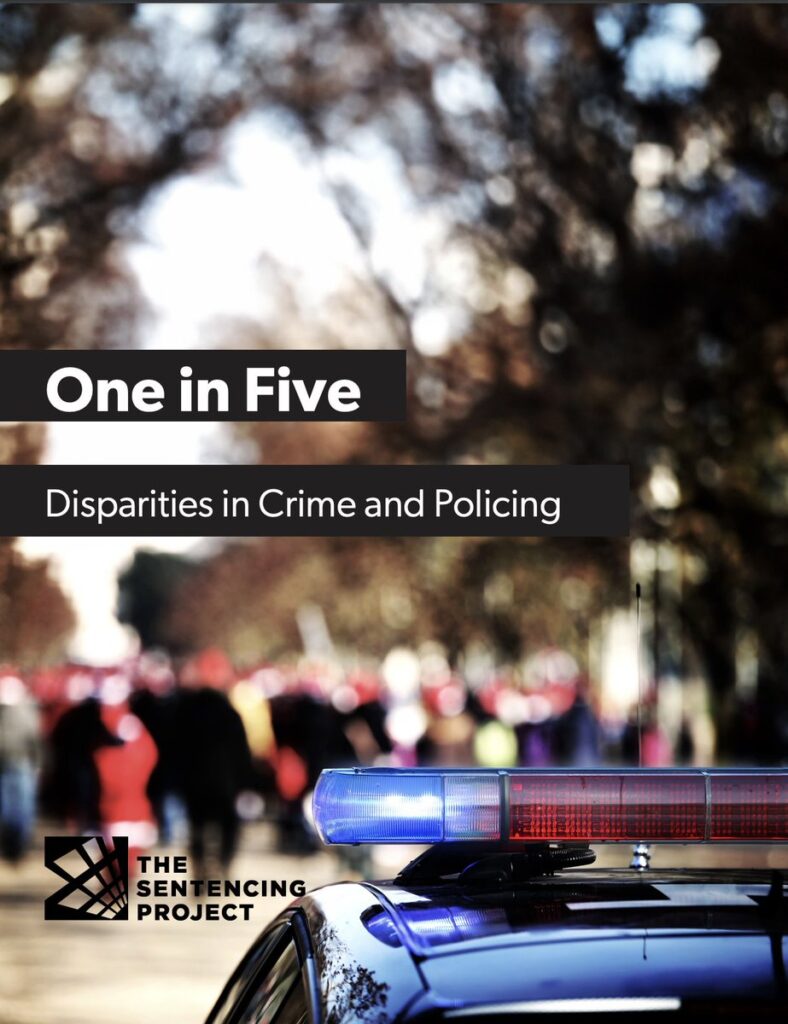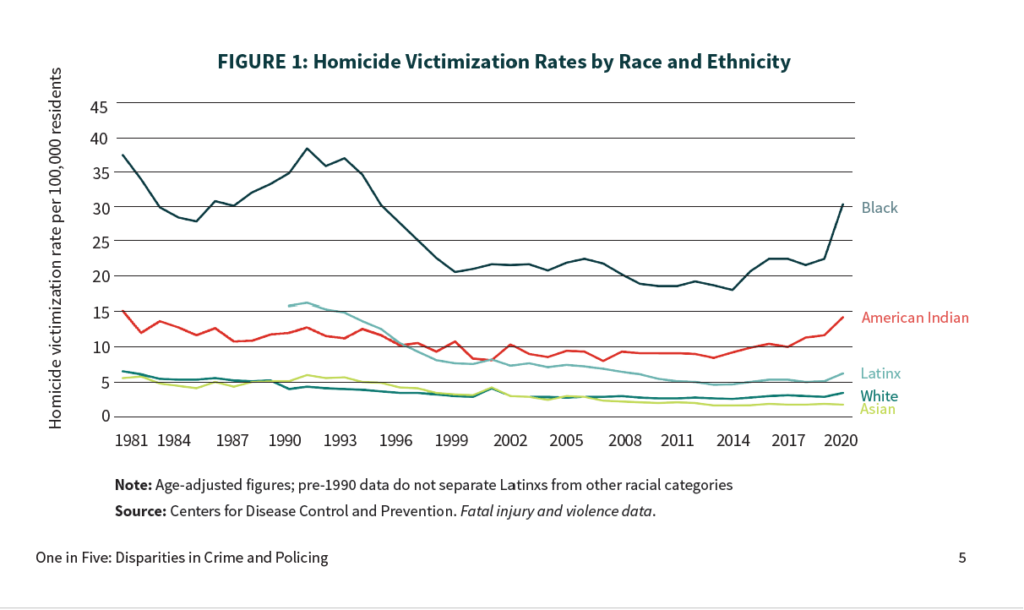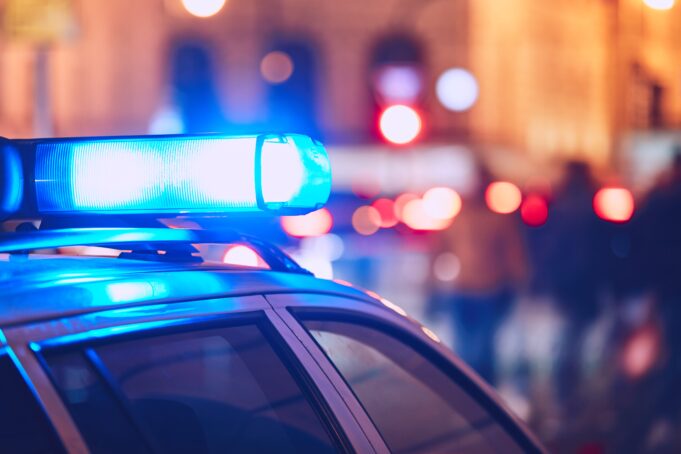A wide net that police cast across Black communities and other non-White communities is at odds with advancing safety, according to a new report by the Sentencing Project. The Sentencing Project advocates for effective and humane responses to crime that minimize imprisonment and criminalization of youth and adults by promoting racial, ethnic, economic, and gender justice.
It’s “One in Five: Disparities in Crime and Policing,” report released November 2, indicates that excessive police contact often fails to intercept serious criminal activity and diminishes the perceived legitimacy of law enforcement.
In addition, scholars have declared a “generational shift” in the lifetime likelihood of imprisonment for Black men, from a staggering one in three for those born in 1981 to a still troubling one in five for Black men born in 2001, according to the report, authored by Nazgol Ghandnoosh, Ph.D. and Celeste Barry.
“As the Most Honorable Elijah Muhammad has taught us, the study of history is a must, because it is most qualified and attractive to reward our research. So, we must know that the police force was never established for public safety. It initially was established as slave catchers to enforce the fugitive slave acts,” stated Student Minister Abdul Haleem Muhammad, Southwest Region Representative for the Honorable Minister Louis Farrakhan and the Nation of Islam.
Police were also established to enforce convict leasing (to private railways, mines, and large plantations), once Black people were emancipated, he said. Their purpose was to also enforce segregation by practice or by law when Black people moved from the South to the North, he added.
“The only and best solution is separation. This system cannot be reformed. It has to be replaced, and this is why Allah (God) declares in the scriptures, Behold! He makes all things new,” stated Student Minister Haleem Muhammad.
Dorsey Nunn is the executive director of Legal Services for Prisoners with Children, which organizes communities impacted by the criminal justice system and advocates to release incarcerated people. Mr. Nunn thinks that there is a disproportionate impact throughout the legal system.
“I think that the question is not just a question for Black males, it’s a question for the entire Black community because you can’t lock up as many people as they’ve got locked up without locking up our brilliance and genius … without necessarily having some side effects,” said Mr. Dunn to The Final Call.

“One in Five: Disparities in Crime and Policing,” found that a high volume of police contact fails to address the higher rates of serious violent offending and victimization among Black and Brown communities and sometimes exacerbates these problems.
“I can’t breathe,” George Floyd said over 20 times. “Every time you see me, you want to mess with me,” said Eric Garner. “I just want to go home,” said Tyre Nichols. Breonna Taylor asked who had come into her apartment in the middle of the night. Police killed them all,” the report underscores.
“I’m getting tired of that same old story, they (police) felt like (they were) in fear for their life. I got a life too, and every time I have been pulled over, I always think, is some crazy person going to shoot me, because I reach for some document that they asked me to retrieve, and I get shot! Do I have to stand out there and actually control my frustration levels, because I don’t even think Black people are entitled to have anger without actually appearing to be justifying people being afraid and causing them to harm us more often than we are harming them,” argued Mr. Nunn.
A solution is for police to just stop with pretext stops, stopping people for having a broken tail light or because their tags aren’t up-to-par, he said.
“You could have some other reason to stop them, like did they violate the law. But if you really get down to it, are you just doing rule violations or are you actually stopping somebody because you’re actually protecting public safety?” added Mr. Nunn.
The Sentencing Project report further specifically found:
• Black Americans were 9.3 times as likely as Whites to be homicide victims in 2020, American Indians were 4.3 times as likely, and Latinos were 1.9 times as likely, based on age-adjusted figures. Since homicide is generally an intra-racial crime, these figures correspond to higher rates of homicide offending among these communities of color, which is attributable to spatially concentrated urban poverty resulting from longstanding and ongoing segregation, discrimination, and disinvestment.
• Police officers’ reliance on millions of minor traffic stops annually as a pretext to investigate drivers for criminal activity disproportionately impacts Black and Latino drivers. Among those they pull over, police are more likely to search Black (6.2 percent) and Latino drivers (9.2 percent) than Whites (3.6 percent). But police are often less likely to find drugs or weapons among the Black and Latino drivers that they search, compared to Whites.
• Black and White Americans use illicit drugs at roughly similar rates, but about one in four people arrested for drug law violations are Black, although Black people make up just 14 percent of the U.S. population.
In addition, excessive policing also distracts policymakers from making investments to promote community safety without the harms of policing and incarceration, the report notes.
“The Black Lives Matter movement has rightly highlighted the tragic deaths resulting from policing’s biased and excessive contact with people of color. Nearly half of those killed by police in recent years have been Black or Latinx, and officers are rarely held accountable,” stated authors, in their executive summary.

They recommended that to meaningfully tackle serious crime, policymakers need to make meaningful investments in interventions outside of policing and end the harms of excessive police contact.
“It’s not new to us, Black folks in our community, about what the Sentencing Project has come up with. We know what the Sentencing Project is saying, but there’s always pushback, a backlash or a ‘White-lash,’ as we call it when we try to do something good for our neighborhood and as we begin to get some changes in place,” said Cephus “Uncle Bobby” X, co-founder of Love Not Blood Campaign and Families United 4 Justice.
“It gives the appearance that things have gotten just a little better because instead of three of us, it’s one in five of us now, with these pretextual stops, which is why we argued for AB 953 (Racial and Identity Profiling Act of 2015) that requires every police officer that makes a stop to take the demographics of the individual that they stopped,” stated Cephus X.
Studies of what happened after low-level pretextual stops showed that more Black and Brown men were being killed by police, such as Daunte Wright, he stated as an example.
The 20-year-old father was shot and killed by former Minnesota police officer Kim Potter. Ms. Potter, who was convicted of second-degree manslaughter and given a two-year sentence was released from prison on April 24. She said she mistook her gun for a Taser when she shot Daunte Wright, who has a Black father and White mother.
“In essence, have things really improved? I would argue, no,” Cephus X told The Final Call. “Every time we talk about investment in our community that we know will help solve the inner struggle that we go through when it comes to us dealing with each other is part of the justification for policing to say that they need to police our neighborhood to a greater extent because of all the criminal activity, which really isn’t near as bad as they claim it to be,” he said.
“I mean, we know we have criminal acts going on in our community. But the dope that we get caught with is the same amount of dope that White folks get caught with, but yet, we’re the ones going to jail more so than they are,” he added.
According to “One in Five’s” research on “Stop Outcomes: Searches, Arrests, and Police Violence,” national surveys, as well as studies of specific jurisdictions, reveal disparities in the outcomes of police stops. After pulling a driver over for a traffic stop in 2018, officers nationwide searched Black and Latino drivers 1.7 and 2.6 times as often as Whites, respectively, the report indicates.
Further, this disparity holds even though police are less likely to find illegal drugs, weapons, or other forms of contraband such as stolen goods in the cars of Black and Latino drivers than those of Whites, it found.
These patterns of “contraband hit rates” have been found in jurisdictions across the country, including Philadelphia, Missouri, and California, the report continues. Because they are searched so much more frequently, Black and Latino drivers are arrested more frequently than Whites in police stops—a disparity that would be reduced if they were searched at the same rate as Whites, it added.
In addition to 1) The disparate racial impact of laws and policies; 2) Racial bias in the discretion of criminal legal professionals; 3) Policies and decisions that disadvantage low-income people, and; 4) Policies that exacerbate socioeconomic inequalities, authors indicated that “One in Five’s” remaining installments aim to also highlight promising reforms that dismantle these inequities.
“The question is asked, is citizen oversight with independent auditors really working, can the policing agencies be reformed? And there’s so much pushback in trying to reform them, that it’s almost like you want to say, no. They can’t be reformed. It has to be totally torn down,” said Cephus X.












